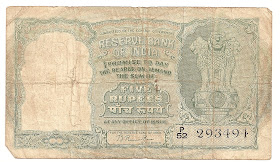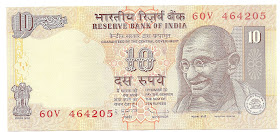Did you know series (2) : What is the design or focus of the picture on the back of the currency notes in circulation in India?
We have all used various denominations of currency notes which are in circulation in India in all activities of life, be it going to the cinema, purchasing groceries, clothes, shopping at Malls etc. but how many of us have actually paused to check out the designs, which have been placed on the back of the currency notes that we have been using, by the Currency Printing Press Note designers, after investing considerable thought?
Naturally, the common excuse would be, that, who has the time to check out this, we are very busy people, and who uses currency these days – we use credit/debit cards, but, if you would spare just a few minutes and read this article, you would know for sure, which design goes at the back of which denomination of currency note.
Also, knowing about these designs sometimes makes for an interesting conversation starter/engrosser, with all those present around you (including strangers!), checking out the currency notes in their wallets/purses.
Five rupee note Design:
The first series/design at the back of this currency denomination was a herd of deer/antelopes, three in front and al least three in the background. The focus was on saving/caring for India’s wildlife.
I have one currency note issued during the tenure of Sir Benegal Rama Rau was the Governor of Reserve Bank of India (1949-1957). This design could be seen in circulating currency notes till mid to late seventies.
My currency note given below, was put in my shoe box collection in the mid seventies. (One must remember that, a five rupee note in the 1970s had a lot of value, and I was a University student then, studying Law. For me to put aside this Note in those days from my monthly expenses, was quite an effort, or should I say, quite a sacrifice!)
My currency note given below, was put in my shoe box collection in the mid seventies. (One must remember that, a five rupee note in the 1970s had a lot of value, and I was a University student then, studying Law. For me to put aside this Note in those days from my monthly expenses, was quite an effort, or should I say, quite a sacrifice!)
Obverse of the five rupee note mentioned above.
Reverse of the same note showing the picture of the six deer/antelope herd.
After a few minor experiments with the reverse side designs, the first issues of a replacement design which is still continuing till the present day , were circulated during the tenure of Reserve Bank Of India Governor, S. Jagannathan, (1970-1975). This design shows a farmer ploughing land with a tractor, and the sun rising behind a couple of mountains. The symbolism, suggests that, modern technology is now at the disposal of our farmers, while the rising sun denotes peace and prosperity (through agricultural development).
Obverse of a note issued during the time of R.N. Malhotra (RBI Governor from 04.02.1985 to 22.12.1990) showing the Lion Capital which was replaced by the portrait of Mahatma Gandhi in the later series.
Obverse of two notes issued during the tenures of Drs. Bimal Jalan (RBI Governor 22.11.1997 – 05.09.2003) and D.Subbarao, (RBI Governor from 05.09.2008 onwards) both issued under the Gandhi series. Both these notes are in mass circulation now.
Reverse of the two notes showing the Tractor and rising sun design. In the second Note, the year 2009 is also mentioned, below the design, indicating, the year of issue for the Note.
Ten Rupee Note Design:
The first notes of this denomination were large notes, with a sailboat having three sails on the reverse, with mountains in the background.
I have a ten rupee Note issued during the time of Sir Benegal Rama Rau (RBI Governor 1949-57), which I, also, saved in the mid-seventies, while I was a University student.
Obverse of the Note mentioned above. Notice that , as was the practice during British India times, this currency note is issued only in English, except for the words “ Dus Rupiya “ (Ten Rupee) in Hindi, whereas, the present day issues , have Hindi preceding English, being the official language of the Indian nation . Also, notice, that the “Rupiya” (Rupee) in Hindi is singular, whereas, present day issues, under the Gandhi series, spell it as “Rupiye” (Rupees) in Hindi, which is the correct spelling for plural, for Rupees.
Reverse of the Note as above showing a sailboat/Dhow with three sails being manned by a few sailors. Dhows were extremely versatile boats and were extremely popular for trade between the Western coast of India and Arabic countries for several centuries.
The Dhow design continued till the eighties, with a few experimental designs of a hajj pilgrim, Persian Gulf, peacocks, then later, Shalimar Gardens.
Obverse of a ten rupee note issued under the signature of RBI Governor, S. Jagannathan, (16.06.1970-19.05.1975). This note is still accepted as circulating currency, particularly, in rural India. I happened to collect this specimen, during a trip to a rural Warli tribal village, a few hours journey from Mumbai, to interact with the artisans making artifacts with the famous Warli Tribal Art designs. Notice that only the numeral “10” is given here, but, the words “Dus rupiya” (ten rupee) has changed to “Dus rupiye” (ten rupees) in Hindi, but no English version of "ten rupees" is given, except on the RBI Governor’s certificate.
Reverse of the ten rupee note given above, showing the sail-boat/Dhow design. Notice that, whereas, in the earlier design, there were four or five sailors manning the sails of the sailboat, and there were only two mountains ahead of the first sail, in this design, the sailboat seems to be unmanned, and now there are three mountains ahead of the front sail. Apparently, it would seem that the “boat” is moving on its own, and has actually moved backwards, instead of forward (a subtle hint, perhaps of the ‘inflationary” trends in the Indian economy, and the Economy drifting rudderless, by the Note’s Master Designers?? :-)
Obverse of notes issued by RBI Governors, S.Venkitaramanan (22.12.1990 -21.12.1992) and C.Rangarajan (22.12.1992 – 22.11.1997). You may still come across this note in circulating ten rupee notes.
Reverse of the Note as above showing the Diwan-i-Khas of the Shalimar Gardens, in Kashmir.
The present circulating designs are from the new Gandhi series.
Obverse of a Note from the new Gandhi series issued under the signature of D.Subbarao (RBI Governor from 05.09.2008 onwards).
Reverse of the same Note, showing a rhinoceros, an elephant and a tiger, symbolizing wildlife conservation.
Twenty Rupee Note Design:
Twenty rupee Notes were issued for the first time, during the tenure of RBI Governor S.Jagannathan (16.06.1970 – 19.05.1975). The earlier notes depicted Parliament House and the later ones, had the wheel at the Konark Sun temple. You may come across the Konark sun temple wheel design issues as part of circulating currency.
Obverse of an old design note issued under the signature of RBI Governor, C.Rangarajan, (22.12.1995 – 22.11.1997) showing the Lion Capital.
Reverse of the Note as above, showing the Wheel of "Surya's" chariot at the Konark Sun temple, in the Indian State of Orissa.
The above design was changed in the Gandhi series note issues to depict palm trees, Mount Harriet, Port Blair Light house, a Bay and clouds. This design is in mass circulation now.
Obverse of a Note issued under the Gandhi series, signed by RBI Governor, Y.V.Reddy (06.09.2003 – 05.09.2008).
Reverse of the Note as above, showing the Bay, palm trees, clouds, Port blair Light house & Mount Harriet.
Fifty Rupee Note Design:
Fifty rupee Notes were, also issued for the first time, during the tenure of RBI Governor S.Jagannathan (16.06.1970 – 19.05.1975). The reverse designs showed the Indian Parliament, without the Indian Flag, which was changed to the Indian Parliament having the Indian Flag as in the issues currently in circulation.
Obverse of a fifty rupees Note having the Lion Capital emblem issued under the signature of RBI Governor, Bimal Jalan. These Notes are still in circulation and accepted as currency.
Obverse of a Mahatma Gandhi series Note, issued under the signature of RBI Governor , Y.V. Reddy (06.09.2003 – 05.09.2008),
Reverse of the above Note, showing the Indian Parliament, also, but with a much different design and a closer view (Perhaps , a subtle indicator, that, what happens in the Parliament, is under greater public scrutiny, than ever before:-).
Hundred Rupees Note Design:
Various designs have graced the hundred rupee currency note viz, two elephants , just after Independence, Hajj pilgrim, Persian Gulf, A Dam, Gandhiji with a book, a picture of Agricultural development, the latest being a picture of ice-capped glorious Himalayas.
Obverse of a specimen issued under the signature of RBI Governor Y.V.Reddy under the new Gandhi series. This Note design is currently in circulation.
Reverse of the above Note, showing a view of the ice-capped glorious Himalayas, with clouds in the background.
Five Hundred Rupees Note Design:
The five hundred rupee notes were issued for the first time, during the tenure of RBI Governor, R.N.Malhotra (04.02.1985 – 22.12.1990). It depicts Mahatma Gandhi’s famous Dandi March in 1930, when he walked upto the village of Dandi on the sea coast from his Sabarmati Ashram to protest against the Salt Tax being levied on Indian users by the British India Government. (I have covered this in detail in my post on Mahatma Gandhi on this blog).
Obverse of a Note from the First Gandhi series, issued under the signature of RBI Governor, C.Rangarajan. You may still come across this series once in a while in circulation, but have to be careful, regarding fakes.
Obverse of a Note issued under the new series Mahatma Gandhi design under the signature of RBI Governor D.Subbarao.
Reverse of the above Note, also, showing Mahatma Gandhi’s Dandi march ,as in the earlier series.
One thousand Rupee note design:
Although 1000 rupee Notes have been in existence in India, since Independence, they were demonetized and reintroduced ,only, in the last decade. These notes depict images of the Economy of India on the reverse.
Obverse of a one thousand rupee Note, issued under the Mahatma Gandhi latest series under the signature of the present RBI Governor, D.Subbarao .
Reverse of the above Note, depicting various facets of the Economy of India.
1) Introduction of the new Rs.2000/- denomination in Indian Currency circulation wef 10.11.2016
2) Classification and Valuation of Rs.1000/- denomination Banknotes
3) Classification and Valuation of Rs.500/- Banknotes
4)Classification and Valuation of Rs.100/- Notes
5) Classification and Valuation of Rs.50/- Notes
6) Classification and Valuation of Rs.20/- Notes
7) Classification and Valuation of Rs.10/- Notes
8) Classification and Valuation of Rs.5/- Notes
9) Evolution and Valuation of one Rupee Banknotes in India
10) Did-you-know-series-1: Assists for identification of Currency Notes by visually challenged users
11) Did-you-know-series-2-what-is-design-or focus of the picture at the back of circulating Currency Notes in India?
12) Are you carrying a Fake Rs.500/- Banknote in your purse/wallet?: A comprehensive study
13) Introduction of a Rs.200/- Banknote wef 25.08.2017: Reasons for introduction, Necessity & convenience to Users
Some interesting links on Indian coins on this Blog:

































Fantastic post!
ReplyDeleteI was intrigued by the farm house looking building on the reverse of the 10 rupee note and had been searching for it for a long time now. I am happy to learn that it is Diwan-i-Khas of Shalimar Gardens.
Thank you so much (:
Happy to know that this post was of some use to you.
ReplyDeleteI have 500 rupees note of (04.02.1985 – 22.12.1990) if any body want to purche it contact me +91-9984211146
ReplyDelete